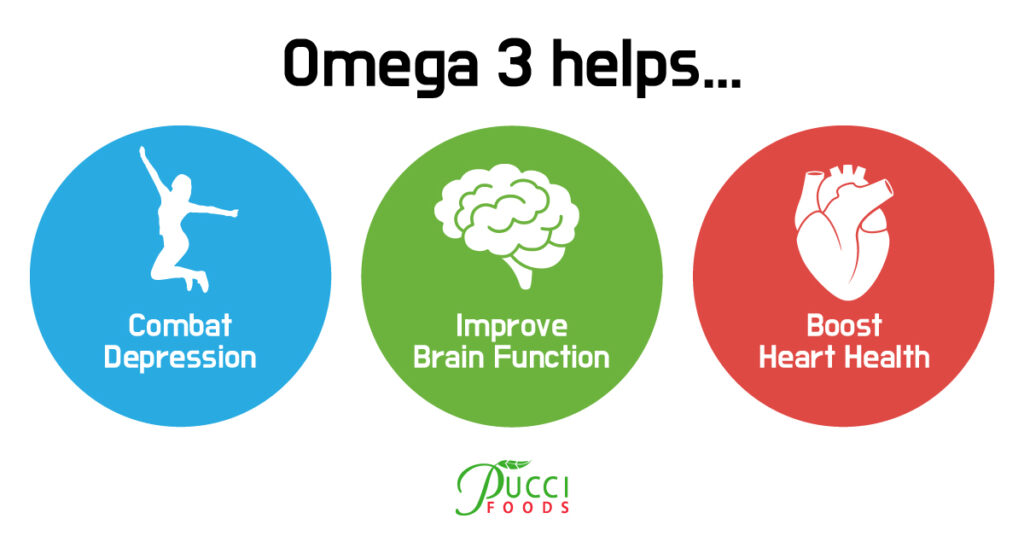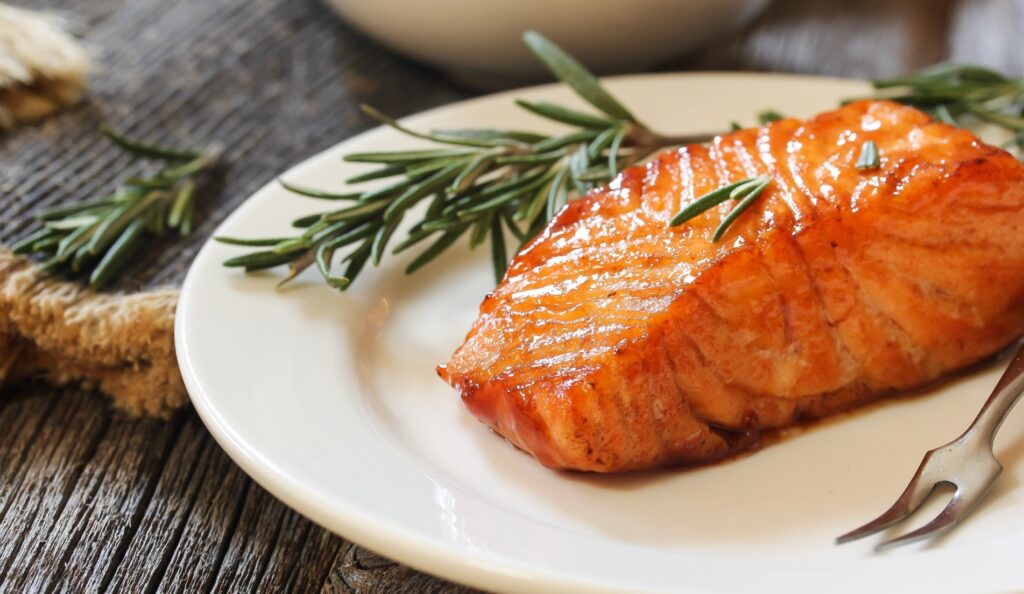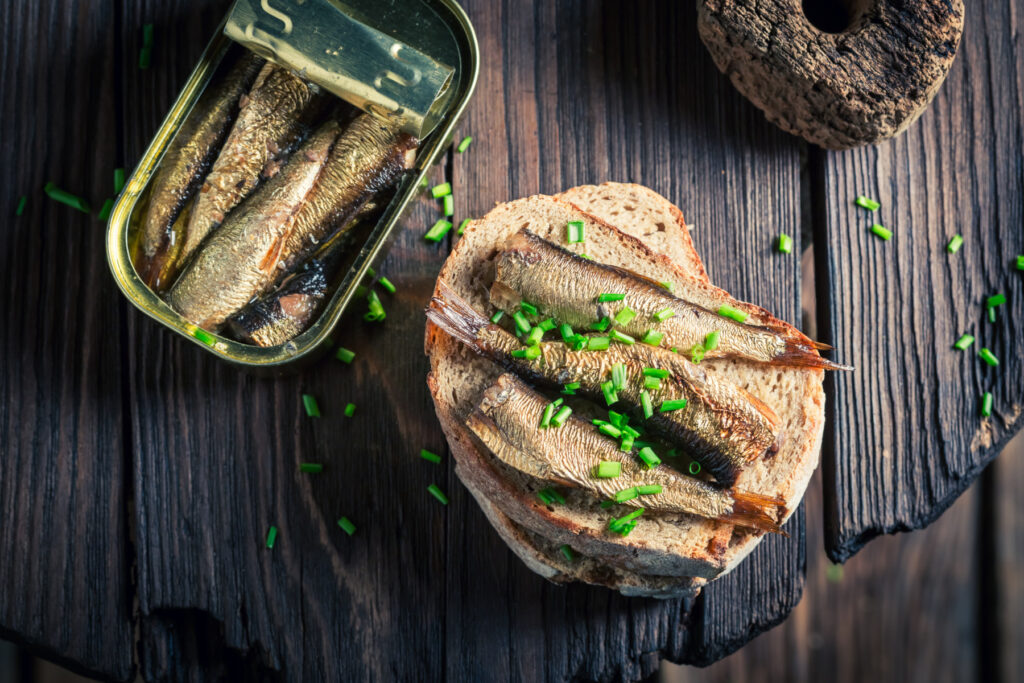Overview:
EPA and DHA Omega 3s help fight symptoms of depression, improve attention, and boost heart health.
Foods rich in EPA and DHA Omega 3s include salmon, mackerel, sardines, anchovies, trout, herring, and sablefish.
Plant sources of omega 3 DO NOT contain EPA and DHA. Rather, they contain the ALA form of omega 3, which is not directly linked to the health benefits listed in this article.
Omega 3 fatty acids are essential and wonderful. Below, we explain what omega 3s are and list some of the biggest benefits of consuming them. To do this, we summarize results from three peer-reviewed scientific studies. We also give an overview of how omega 3s work, and how to incorporate them into your diet.
What are Omega 3s?
Omega 3s are a type of polyunsaturated fatty acid (PUFA), often referred to as “the good kind of fat.” Omega 3s are also an essential fatty acid, meaning we need to seek them out in our diet. There are three forms of omega 3 fatty acids found in foods we consume:
- alpha-linolenic acid (ALA) – found in plants and nuts
- eicosapentaenoic acid (EPA) – found in fish
- docosahexaenoic acid (DHA) – found in fish
Most studies indicating health benefits from consuming omega 3 involve the EPA and DHA forms, which we focus on in this article.
Benefits of Omega 3

There are many benefits associated with consuming EPA and DHA omega 3 fatty acids, but we chose to focus on three benefits you may find most useful. Omega 3 helps…
- Combat symptoms of depression
- Improve mood, mental acuity, & reaction time
- Boost heart health
We investigated three peer-reviewed scientific studies that support each of these claims, the results of which we’ve summarized below.
Scientific Studies Indicating Benefits of Omega 3
1. EPA Omega 3 Combats Symptoms of Depression
A group of participants diagnosed with Major Depressive Disorder were randomly assigned to one of the following treatments (1) Fluoexetine (an anti-depressant medication), (2) an EPA omega 3 supplement, or (3) a combination of both. Depressive symptoms were measured at the beginning and end of 8 weeks. The EPA omega 3 supplement was just as effective at controlling depressive symptoms as the antidepressant, Fluoexetine. The combination of the two treatments was significantly more effective than either treatment alone.
Comparison of therapeutic effects of omega-3 fatty acid eicosapentaenoic acid and fluoxetine, separately and in combination, in major depressive disorder (Australian & New Zealand Journal of Psychiatry)
2. EPA Omega 3 Improves Mood, Mental Acuity, & Reaction Time
A group of participants were randomly assigned to take either an EPA supplement or an olive oil placebo for 30 days. Measures of mood and attention were taken before and after the treatment period. The researchers state: “The mood profile was improved after omega 3 with increased vigour and reduced anger, anxiety and depression states. This was associated with…a reduction of reaction time.”
Cognitive and physiological effects of Omega-3 polyunsaturated fatty acid supplementation in healthy subjects. (Eur J Clin Invest)
3. EPA and DHA Omega 3 Boosts Heart Health
13 trials of marine omega 3 supplementation were analyzed together. Marine omega 3 supplementation was associated with lower cardiovascular disease (CVD), lower rates of CVD death, lower rates of heart attack, and lower rates of death from coronary heart disease.
Marine Omega-3 Supplementation and Cardiovascular Disease: An Updated Meta-Analysis of 13 Randomized Controlled Trials Involving 127 477 Participants (J Am Heat Association)
Foods High in Omega 3
How much omega 3 do I need?
Most experts recommend we take 250–500 mg of combined EPA and DHA omega 3 per day (Healthline).
What foods are high in EPA and DHA?
Below we’ve listed foods rich in EPA and DHA omega 3s. Keep in mind that 3.5 oz of fish is roughly a fillet the size of a checkbook. Sustainability ratings are based on Monterey Bay Aquarium Seafood Watch Program, unless otherwise specified.

Atlantic Salmon – 2586 mg / 3.5 oz.
Sustainability Rating: Tank Farmed – “Best Choice”; Ocean Farmed – “Good Alternative”

Atlantic Mackerel – 1422 mg / 3.5 oz.
Sustainability Rating: Gulf of Mexico – “Good Alternative”

Anchovies – 2113 mg / 3.5 oz.
Sustainability Rating: Argentina Trawled / Spain Purse Seines – “Certified”; All Else – “Avoid”

Sardines – 1692 mg / 3.5 oz.
Sustainability Rating: Pacific Sardine – “Certified”; All Else – “Avoid”

Trout – 1370 mg / 3.5 oz.
Sustainability Rating: Good (EDF Seafood Selector)

Sablefish – 2125 mg / 3.5 oz.
Sustainability Rating: mostly “Best Choice” (see Seafood Watch for other cases)

Herring – 2217 mg / 3.5 oz.
Sustainability Rating: US – “Best Choice”; All Else – “Certified”
What about mercury?
We’ve only listed seafood choices that are low in mercury, and health experts agree that, “for most adults, the risk of getting too much mercury or other contaminants from fish is generally outweighed by the health benefits of omega-3 fatty acids.” (Mayo Clinic)
Why Americans especially need omega 3s?
On average, Americans eat a lot more meat than they do fatty fish. This contributes to a high omega 6 to omega 3 ratio, which is associated with increased inflammation and higher risk of heart disease (CMAJ). One way to rebalance the ratio is by decreasing meat consumption and increasing fatty fish intake. Choose seafood that is fresh, traceable, and sustainable. When eating meat, choose beef from grass fed and finished cows. Grass fed cows have an omega 6 to omega 3 ratio of 1:1, as opposed to the 26:1 ratio found in meal fed cows (Lex Fridman Podcast #203)
How do Omega 3s work?
Omega 3 Mechanism of Action
Omega 3 fatty acids are incorporated into cell membranes, or the “skin” surrounding each of our cells. Omega 3s are critical in the protein signaling and communication with other cells. In other words, they are crucial to the proper functioning of our bodies. Brain and heart cells have the highest concentration of omega 3 fatty acids in their membranes (CMAJ).
Conclusion
Scientific research has linked omega 3s to many health benefits. Consuming fatty fish can give you access to these benefits and rebalance your omega 6 to omega 3 ratio. Choose fish that is fresh, traceable, and sustainable.
We sought to be transparent about the scientific information regarding omega 3 fatty acids and the different types of fish listed. We offer this information as a guide for you to make your own decisions regarding your diet and health in consultation with your doctor.
For ideas on how to cook fish, check out our blog!
Pucci Foods is a 100 year old seafood distributor based in Hayward, California. We are known for going above and beyond for our customers in supplying quality seafood in a sustainable way. From fresh wild catch to affordable, sustainably farmed species, we are the seafood solution for restaurants, retailers, institutions, and wholesalers who are looking for fresh quality, committed care, and sustainable satisfaction.



